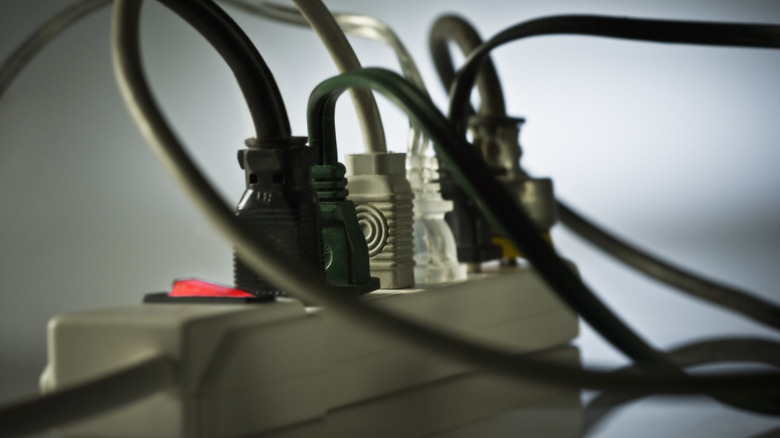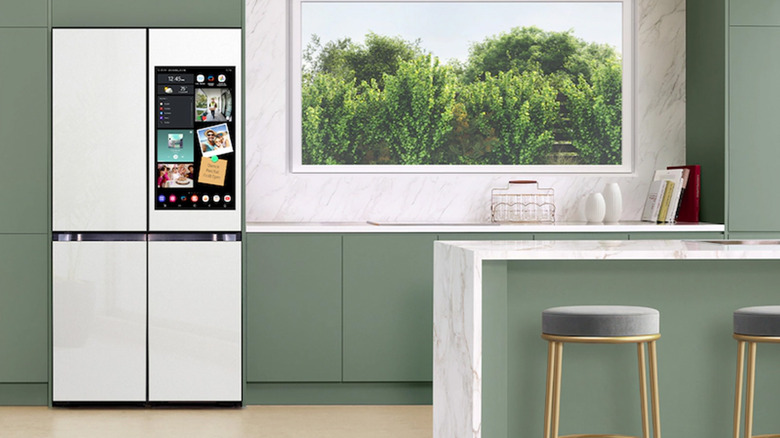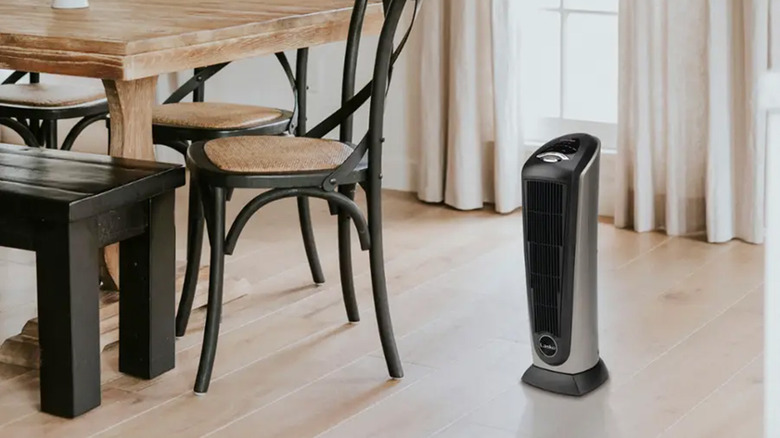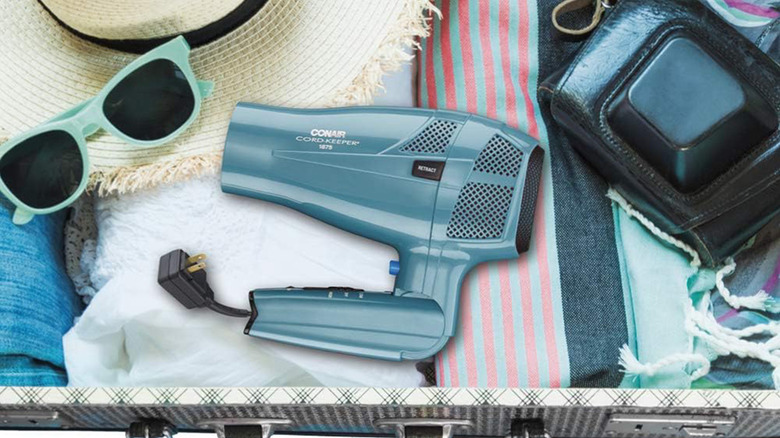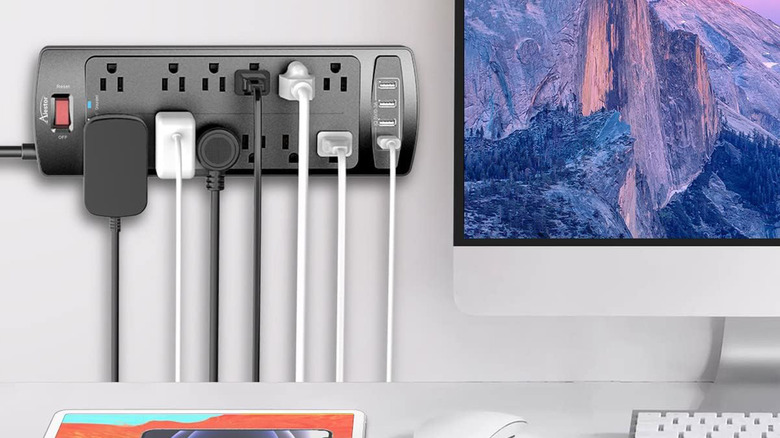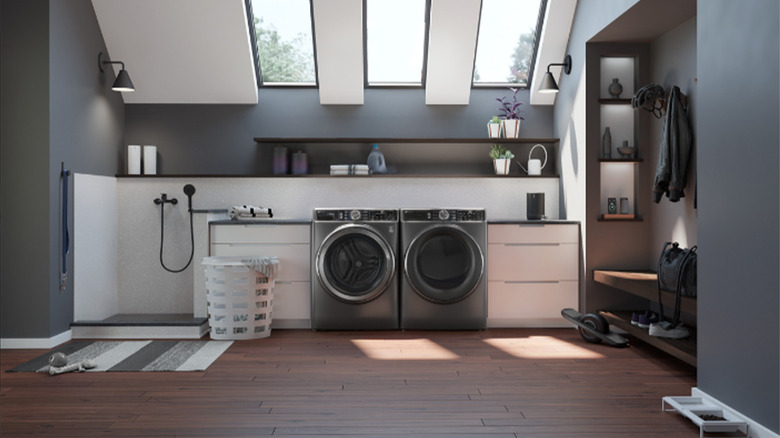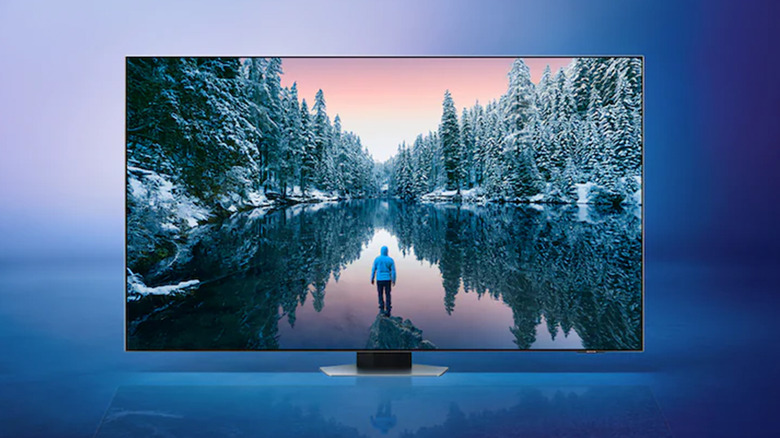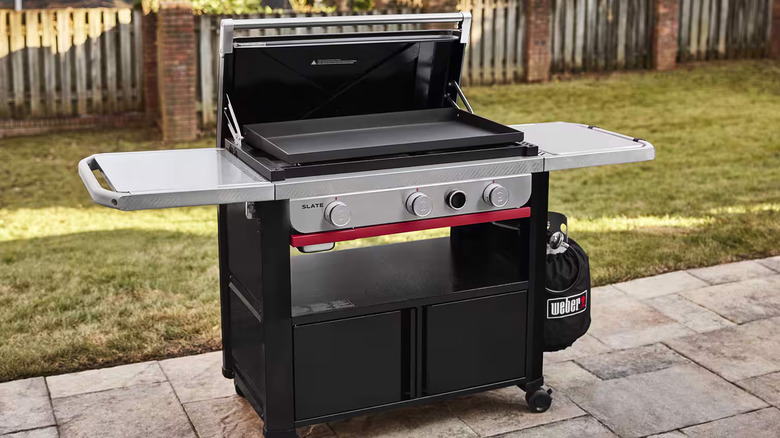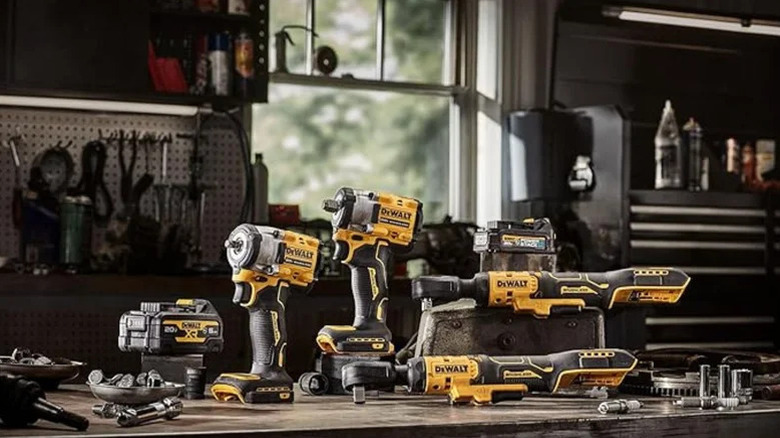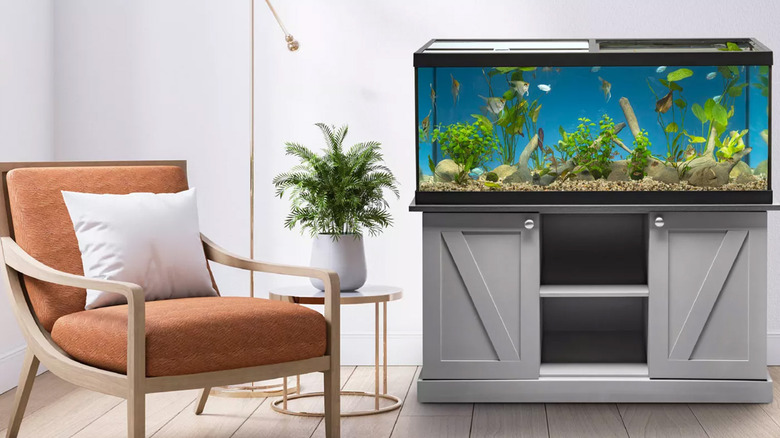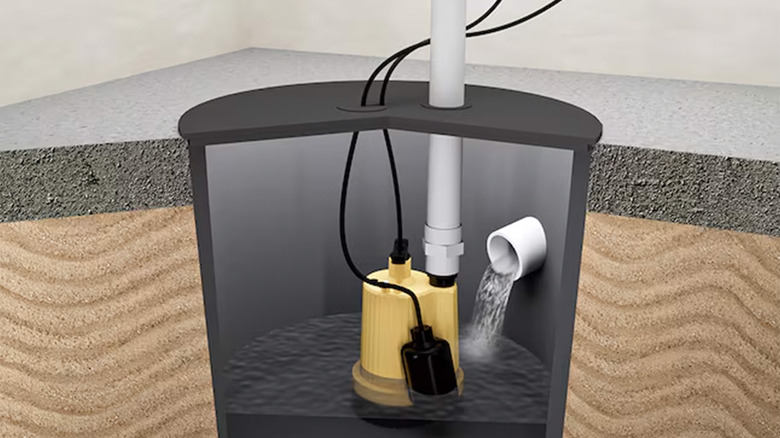10 Things You Should Never Plug Into A Power Strip
We may receive a commission on purchases made from links.
Power strips are popular, useful tools that you can find in almost any home. Everybody knows what they do, and in an age where more things need cables, power strips have almost become a necessity. Most homes weren't built with enough outlets for smartphones, tablets, Kindle e-readers, TVs, game consoles, and all of the rest of the technology that people use every day. Thus, many supplement their outlet selection with power strips or something similar to turn two plugs into six.
Generally, this isn't dangerous, but it can quickly become a problem if proper safety isn't observed. An overloaded power strip can cause all sorts of issues, from frying your electronics to catching fire. Usually, this happens because one or two items on the power strip draw way more power than it can handle. That's why most experts recommend only plugging in low-power items and using a power strip with a surge protector.
Along with the above advice, some devices should never be plugged into a power strip. These items should always be plugged directly into a wall outlet because they can easily overload a power strip by themselves, and that's not even counting anything else plugged in. If you need a quick answer on what not to plug into a power strip, the list is simple: If it generates a lot of heat, has a compressor, or has a powerful motor, you shouldn't use it with a power strip.
Kitchen appliances
First up is kitchen appliances. This one is fairly evident, but just in case, here's why. Nearly every kitchen appliance – whether it's a refrigerator, microwave, or even a high-powered blender — either has a compressor, generates tons of heat, or runs on a powerful motor. To give you an idea, most power strips are rated for about 1,800 watts. A consumer microwave can pull anywhere from 600 to 1,700 watts, while commercial microwaves can go well over 2,000.
There aren't many kitchen appliances that don't draw a lot of power when they operate. The lowly waffle iron can pull up to 1,200W in some cases while a fridge can do up to 800W. Toasters, coffee makers, and even electric skillets can easily top 1,000W. So, while you might get away with plugging in a single appliance, it defeats the purpose of a power strip anyway. Stacking two or three appliances on the same strip will all but guarantee failure.
In addition to all of the above information, power strips are also a terrible idea for kitchens due to other elements. For instance, moisture from the sink will short a power strip pretty quickly, whereas properly installed ground fault circuit interrupter (GFCI) outlets have safety mechanisms in place for moisture. There are simply too many high-powered items in the kitchen to justify it. If you're running out of outlets, a safer option is having an electrician add some.
Large household appliances
While we're on the topic of appliances, most other types of appliances shouldn't be plugged into power strips either. This list is more diverse and includes space heaters, window or portable air conditioner units, vacuum cleaners, and clothes irons, among other things. Many people don't even stop to consider how much power a clothes iron can draw. In case you're curious, a clothes iron can draw up to 2,000 watts of power, overloading most commercial power strips all by itself.
I learned this the hard way. All my garage outlets run on the same breaker, and during a Christmas party, I plugged in two portable heaters to warm up the space for guests who wanted to smoke. Within minutes, the combined load of the heaters and other devices tripped the breaker. I eventually had to run a properly rated extension cord from inside the house to power both heaters. They really pull a lot of power.
Appliances are among the most power-hungry devices in any home. To stay safe, it's best to plug them directly into a wall outlet.
Hairdressing tools
Remember when we said that a lot of folks underestimate clothes irons because of the ridiculous amount of power they can draw? Hairdresser tools fall into that same category. Hair dryers, curling irons, and flat irons top the list, but essentially, any hairdressing tool that generates a lot of heat shouldn't be plugged into a power strip. Fortunately, the list isn't big, so a power strip usually isn't necessary, but it's still important to know.
The biggest offenders are hair dryers and curling irons. Hair dryers can draw anywhere from 1,500W to 2,000W, meaning a high-powered model can overload a 1,800W power strip on its own. Curling irons and flat irons don't draw as much, but if you plugged all three into a single power strip, it would cause a failure. In short, don't blow-dry your hair while warming up your curling iron on the same power strip — it won't end well.
Professional hair salons avoid this issue by dedicating a separate breaker to each station, ensuring commercial-strength tools don't overload the circuits. At home, many people do their hair in the bathroom, which means the same water-related safety advice from the kitchen appliances section applies here, too.
Extension cords or other power strips
This one is fairly obvious, but it's worth talking about anyway. You should never plug a power strip into another power strip. The practice, commonly known as daisy chaining, also includes using extension cords with power strips or with each other. Not only does this introduce multiple points of potential failure, but it'll also void the warranty on the power strips used in the daisy chain most of the time. Since many power strips come with warranties that cover damages in failures, that means if you daisy chain and it fries your electronics, you are up the proverbial creek without a paddle.
Unlike most of the other entrants on this list, this one is actually a code violation. The National Fire Protection Association (NFPA) is the reigning authority on the matter and writes the rules in the National Electrical Code (NEC). Part of the code states that daisy chaining power strips and extension cords is a fire hazard. In fact, daisy chaining has been the focus of many safety investigations for construction workers and other commercial operations as it is also an OSHA violation.
Logically, it's sound advice. If you have so many things plugged in that you need multiple power strips to fit them all, it dramatically increases the risk of overloading a power strip and causing a fire — even if the devices plugged in don't pose a risk individually. It's ideal to manage your plugs in a safer manner.
Washers
We'll round out the appliance section of this article by talking briefly about washers. Many people don't realize that washers can draw a significant amount of power, even though they use a standard outlet plug. Dryers don't have this issue because they require a specialized plug that no power strip supports. But washers can still consume a lot of electricity, making it best to keep them on a dedicated outlet.
Depending on the model, washers can pull anywhere from 400W to 1,400W. Unlike fridges or air conditioners, they remain idle when not in use, so you can plan their power usage. However, hot water cycles tend to use more power than warm or cold cycles, and since a 1,400W washer alone nearly maxes out most power strips, it's best to play it safe. Plus, washers are usually located in areas of the home that don't require many other electrical devices, so it's rare that you'll run into a scenario where your washer would need to share an outlet.
Fun fact: Washers use about the same amount of power regardless of load size. Thus, it's more energy-efficient to always do full loads versus small loads, as you're using the same amount of electricity either way. So, no — you can't cheat the system by using a power strip with a washer and running smaller loads.
Multiple electronics at once
For the most part, electronics are generally safe to use with a power strip. I've personally done this for years with both my living room entertainment setup and my work PC. Generally speaking, no individual electronic device uses so much electricity that it'll overload a power strip on its own. If this were a significant problem, homes across the U.S. would be burning down, as many folks use power strips to plug in their TV, a game console, and other electronics.
The key to safety is not using all of those devices at once. Modern smart TVs typically consume up to 100W, while an Xbox Series X can draw up to 160W. The PlayStation 5 draws about 200W, while the Nintendo Switch's power consumption is negligible. However, if you plug in multiple devices and use them all at once, those numbers add up. This is especially true if you have a high-end gaming PC, where graphics cards alone can draw hundreds of watts. If you must use a power strip, we recommend one like this Belkin power strip that comes with good surge protection.
Another instance where you want to be careful is laser printers. These can consume anywhere from 500W to 1,300W when running at full power. Audio equipment like guitar or bass amps can draw a significant amount of power. These types of electronics are best left to their own outlets.
Electric grills, smokers, and cookers
As previously stated, anything that generates heat from electricity should never go on a power strip, so it should be no surprise that electric grills, smokers, and other electric cooking implements fit the bill. Outdoor cooking implements are especially risky because they run constantly while in use, and something like an electric smoker may run for a day or longer depending on what you're cooking. In these situations, it's best to just let it have its own outlet to avoid any worries.
In terms of power usage, the amount may surprise you. Electric grills can pump out anywhere from 1,000W to 1,500W. Electric smokers are basically electric grills with a few extra parts, so they use about the same. These alone nearly overload a power strip, so having them plugged into a power strip with other things will almost certainly cause problems eventually. It's also worth noting that grills — especially electric smokers — fluctuate as they operate. My electric smoker will run on high to get the temperature up, sit there for a while, and then run again to increase the temperature by adding more wood pellets.
This is arguably the best example of how things that generate heat use a ton of power. There isn't a low-power mode on an electric grill or smoker, so they draw that much power fairly consistently. They deserve their own wall outlet, or meat won't be the only thing tasting flames.
Corded power tools
Power tools are a bit of an odd bunch. The reason is that power usage fluctuates rather dramatically depending on which tool you're using and how hard you're using it. A good example of this is a power drill. Power drills use around 500W if you buy a basic one for home use, while more powerful drills can range up to 1,500W. So, a standard, basic drill may be okay on a power strip with a shop fan and a couple of lights, whereas a heavy-duty drill would overload that same power strip.
Other types of power tools are much less lenient. Plug-in saws can range from 1,400W to 1,800W, with more powerful variants being able to overload a power strip by themselves. Air compressors can use up to 2,000W depending on the model, while angle grinders and disc sanders can use around 1,000W on their own. Even the humble shop vac can draw 1,400W without breaking a sweat.
Any one of these tools takes up more than 50% of the rated capacity of most power strips, and some draw even more power than a standard power strip can handle. Thus, it's best to use wall outlets or, at worst, properly rated extension cords when using power tools to prevent your workshop from catching fire. In fact, it's also good advice to make sure your wall outlets can handle that many power tools running at once.
Aquariums
Aquariums are perhaps the most unique item on the list of things that you shouldn't plug into a power strip. The reason is that it all depends on the size of the tank, its capabilities, and what attachments are being used. Smaller tanks don't use a lot of power as they can heat themselves pretty easily in colder months, and things like lights simply don't draw a lot of power. Larger tanks require more robust accessories that can draw significantly more power.
Most average aquariums only draw about 60W to 70W, which makes them perfectly safe for power strip use. On larger tanks with more robust accessories, that can go up to 500W or even higher. The biggest difference tends to be heating. Some fish like warmer water, and heating a large tank effectively may require a heater that draws a lot of power. In addition, larger tanks need bigger sumps to properly circulate and filter the water, which can increase power usage as well. Water pumps can range up to 400W for massive aquariums, although hobbyists likely won't need anything that intense.
The best advice is to either give the aquarium its own outlet or double-check your heater, water pump, and other gadgets to make sure they're on the lower end of power consumption. Each piece should have its own rating, which makes it pretty easy to look up.
Sump pumps
Sump pumps should never be on a power strip. These exceptionally important devices pump water out of your house to prevent flooding and often sit in the lowest corner of your home by themselves. Thus, there should rarely be an occasion where a sump pump needs to share a power strip with other items. If you do have the occasion, we recommend using a different outlet for the other stuff. The same goes for well pumps, which extract water from underground wells and pump it into a house's plumbing system.
These pumps can use a huge amount of power, especially when starting up. The average 1/3-horsepower sump pump uses 800W when running and can draw upwards of 2,900W when starting up. More powerful 1/2-horsepower sump pumps increase those numbers to 1,000W when running and upwards of 4,100W when starting up. That means the start-up power alone will overload the average power strip, making sump pumps some of the most power-hungry items in your house that can plug into a regular socket.
Well pumps pull almost identical numbers to sump pumps, so it's best to give any pump like this its own dedicated socket. Much like power tools, it's also not a bad idea to make sure the outlet itself can handle that much power and won't trip a breaker if you intend to step up from a 1/3-horsepower pump to a 1/2-horsepower pump.
General safety advice
Power strips can be extremely useful, especially these days when people have way more electronics strewn about the house than they did 20 or 30 years ago. Power strips are generally safe, especially for low-power devices like smartphones, tower fans, lighting, and other such things. They're even moderately safe for home entertainment use, provided you don't use everything all at the same time.
There are some other safety tips that may help you stay safer. These include unplugging unused devices, ensuring the power strip's cord is an adequate length, and buying quality products when you can. Many power strips come with built-in surge protectors — like the aforementioned Belkin power strip — that add another layer of protection to your devices in the event of a power surge. These little extras can help prevent other types of problems as well.
It's also bad practice to cover power strips or leave them on the floor, as this can negatively impact their ability to cool themselves. Plus, carpet catches fire a lot faster than a solid surface, so if it does overload, you may at least have a chance to put it out before serious damage occurs. If you plan on using a power strip outside, make sure you get one that is rated for outdoor use, as indoor power strips virtually never have the protections an outdoor power strip needs to be safe.
